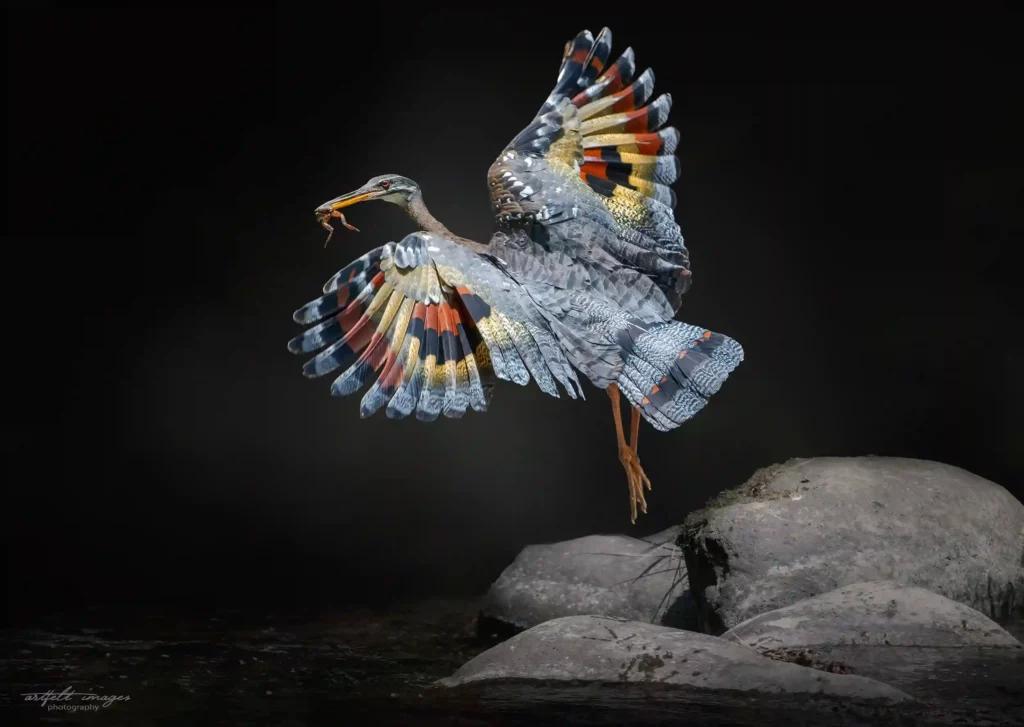Sunbittern
The Sunbittern is a unique and captivating bird, renowned for its striking wing displays that reveal eye-like patterns used to deter predators and during courtship. Despite its name, it is not closely related to true bitterns but occupies its own distinct family, Eurypygidae. In Costa Rica, the Sunbittern is a sought-after species for birdwatchers, often…

Eurypyga helias
Scientific Name
Eurypygidae
Family
Eurypygiformes
Order
E. h. major
Subspecies. Central America, including Costa Rica
Range and Habitat of Sunbittern
Geographic Range
The Sunbittern’s range extends from southern Mexico through Central America to northern South America, including countries like Colombia, Ecuador, and Brazil.
Migratory Patterns
This species is non-migratory, residing year-round within its range.
Preferred Habitat
Prefers forested areas near water bodies such as rivers, streams, and wetlands. It thrives in humid, tropical environments with dense vegetation.
Altitude Range
Typically found from sea level up to 1,800 meters, depending on the region.
Costa Rica Habitat
In Costa Rica, the Sunbittern is commonly observed along forested rivers and streams in areas like Rancho Naturalista, the Sarapiquí River, the Pacuare River, and the Arenal/Fortuna region.
Conservation Status
Least Concern
Conservation Status
Population Status
The Sunbittern is currently classified as Least Concern by the IUCN, indicating a stable population across its range.
Habitat loss due to deforestation and human encroachment poses the most significant threat to the Sunbittern.
Conservation efforts
Conservation efforts focus on preserving natural habitats and protecting forested waterways, which are crucial for the Sunbittern's survival.
Primary Threats
Habitat loss due to deforestation and human encroachment poses the most significant threat to the Sunbittern.
Sunbittern Identification
How to Identify the Species
Rarity Level:
UncommonBest Viewing Times:
Early Morning (Dawn - 8 AM), Evening (Dusk)
Size
Length: Approximately 43–48 cm (17–19 inches) Weight: Around 180–220 grams (6.3–7.8 ounces)
Plumage
The Sunbittern has a generally subdued coloration, with fine linear patterns of black, grey, and brown. Its wings, however, display vivid eyespots in red, yellow, and black when spread, resembling eyes to deter predators.
Distinctive Features
Long, pointed bill; striking wing patterns revealed during displays; and a unique tail-waving behavior where the back side of the body is swayed side to side while the head remains motionless.
Sexual Dimorphism
Males and females are similar in appearance, with no significant sexual dimorphism noted.
Diet and Feeding Behavior
Primary Diet
- Feeds on a variety of aquatic and terrestrial prey, including insects, crustaceans, fish, amphibians, and small reptiles.
Foraging Techniques
- Hunts by walking slowly in shallow water or along the forest floor, using its long neck and pointed bill to spear prey. Notably, Sunbitterns have been observed washing their food before consumption.
Feeding Times
- Primarily diurnal, with peak feeding activity during daylight hours.
Behavior Patterns
Sunbittern
Social Structure
Generally solitary or found in pairs, especially during the breeding season.
Song and Vocalization
Sunbitterns are relatively quiet birds, with vocalizations not being a prominent aspect of their behavior.
Courtship and Mating Ritual
During courtship, Sunbitterns perform elaborate displays, spreading their wings to showcase the vivid eyespots. Both parents participate in nest building and caring for the young.
Territoriality
Territorial during the breeding season, with pairs defending nesting sites along waterways.
Birdwatching Tips
Best Locations for Spotting Sunbittern
In Costa Rica, prime locations include:
- Rancho Naturalista
- Sarapiquí River
- Pacuare River
- Arenal/Fortuna region

Best Time of the Year
Year-round, with increased visibility during the dry season (December to April) when water levels are lower.
Common Behavior
Look for individuals along shaded riverbanks or shallow streams, especially during early morning hours.
Recommended Gear
Binoculars with good resolution, a camera with a zoom lens, and a field guide for identification.
Breeding and Nesting Behavior
Breeding Season
In Costa Rica, the Sunbittern typically breeds during the dry season and early wet season—between February and May, although timing may vary slightly by region.
Nesting Sites
Sunbitterns build platform nests from twigs, moss, and leaves, often placed on horizontal branches overhanging streams or rivers, usually 1 to 4 meters above the water. Nest locations are chosen for concealment and proximity to water.
Clutch Size
Normally 2 eggs, pale buff or creamy in color, sometimes lightly marked with darker specks.
Incubation Period
Both parents share incubation duties for approximately 27–30 days. They alternate shifts and protect the nest from predators with impressive wing displays.
Parental Care
After hatching, both parents care for the chicks, which are semi-precocial. The young stay in the nest for a few days before venturing out with parents along the stream banks. They fledge after 3 to 4 weeks, remaining under parental supervision for an extended period.
Did You Know?
Not actually a bittern
Despite its name, the Sunbittern is not related to herons or bitterns. It belongs to its own unique family (Eurypygidae) and is more closely related to the kagu of New Caledonia.
Wing display defense
When threatened, the Sunbittern spreads its wings to reveal large, eye-like patterns in red, yellow, and black—used to startle predators and rivals.
Stealthy and solitary
Often walks slowly and deliberately along shaded streams or riverbanks, relying on camouflage and stillness to remain undetected.
Unique among birds
The Sunbittern has independently movable toes and a flexible neck, helping it stalk prey like insects, crustaceans, and small fish with precision.